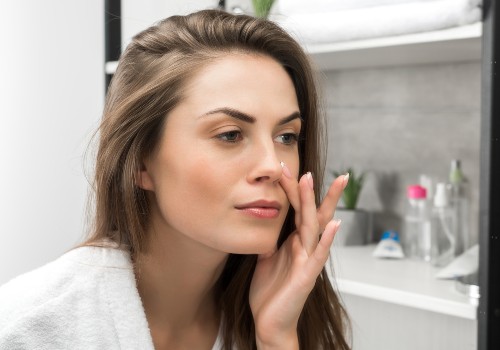Your skin type is the foundation of your skincare routine. The products you use and the treatments you perform should be tailored to your skin type in order to produce the largest benefits.
But what do you do if you don’t already know your skin type?
Don’t worry — follow our easy guide to determine what type of skin you have, then find out how to make it look its best.
Determining Your Skin Type: Two Easy Methods
The Bare-Faced Method: No Tools Required
This method requires nothing but a clean face, a mirror and an hour of your time.
First, cleanse your face thoroughly with a gentle cleanser, then pat it dry with a clean towel. Don’t apply any other products to your face — just cleanse and dry.
Then set a timer for 30 minutes and do something calm that won’t expose you to the sun or cause you to sweat. When the time’s up, look in the mirror and take note of any shiny areas you see.
Wait another 30 minutes, then scrunch your face up in various ways. Try wiggling your nose and eyebrows, then open and close your mouth.
While you do this, observe how your skin feels. Does it move freely, or does it feel stretched, tight or crackly as you contort your face?
The results of these two exercises will tell you your skin type.
If you have just a little shine on your face and your skin doesn’t feel tight, you likely have normal skin. But if your skin does feel tight, you likely have dry skin.
Combination skin will be noticeably shiny on the forehead and nose (but not the cheeks), and may or may not feel tight on the cheeks. If your forehead, nose and cheeks are all shiny, you have oily skin.
The Blotting Method: Quick and Precise
Don’t have the time to do the bare-faced test? A blotting sheet will tell you all you need to know.
Just gently pat the blotting sheet on the different regions of your face (forehead, nose and cheeks) one at a time. After blotting each area, hold the paper up to the light to see how much oil it absorbed.
If you see little to no oil from any area of your face, your skin is likely dry. Normal skin will leave some (but not much) oil on the paper.
Combination skin will leave a lot of oil on the paper after blotting your forehead and nose, but won’t leave much (if any) oil from your cheeks. And if your entire face leaves the blotting sheet saturated, you have oily skin.
The Four Skin Types and What They Mean

Normal Skin: Cleanse and Sustain
Normal skin isn’t “right,” “correct” or any of the other things its name implies. Rather, “normal” simply means that your skin is neither oily nor dry — it’s somewhere in the middle.
This means that you’ll want to avoid products that are heavily drying or overly rich. Your goal is to maintain a stasis for your skin in which it produces just enough of its own oils to stay healthy.
If you have normal skin, you probably don’t break out on your cheeks or experience a lot of skin flaking, but exfoliation is still important. Use a gentle exfoliant every day or every other day to keep your skin fresh and balanced.
Daily cleansing and moisturizing is also important, but stay away from harsh cleansers or super-thick moisturizers. Opt for gel versions of these products as they tend to be lighter and easier on the skin.
Dry Skin: Smooth and Protect
Dry skin doesn’t contain enough sebum (oil) glands to maintain healthy levels of moisture. This results in tight-feeling, flaky, irritated skin that’s more susceptible to damage from the elements.
Many people mistake dehydrated skin for dry skin, and while the two often go hand-in-hand, they’re two different conditions. Dehydrated skin can be rehydrated by drinking plenty of water and using humectant-heavy products, but dry skin can’t be cured so easily — it’s just the way your skin is.
But you can give your dry skin a boost by using rich moisturizers with ingredients like aloe and squalene. A heavy moisturizer compensates for your skin’s lack of natural oil by forming a protective barrier that helps your skin retain moisture.
To improve the appearance of flaky patches, use a non-abrasive exfoliant every day. This creates a smooth surface that makes your moisturizer more effective.
Oily Skin: Exfoliate and Control

The opposite of dry skin, oily skin produces too much sebum, which clogs your pores and makes you look shiny.
But removing all the oil isn’t the answer — in fact, it can often make your skin produce even more!
Rather, oily skin needs exfoliation and gentle cleansing to look its best. An enzyme exfoliant is especially effective at clearing your pores without setting off your sebum glands.
You can also use a non-abrasive physical exfoliant to reduce the appearance of the dark spots that oily skin is so prone to.
And even oily skin needs moisturizing, albeit lightly. A lightweight, non-comedogenic moisturizer will calm your skin down and help it retain a healthy level of moisture.
Combination Skin: Balance and Soothe
Combination skin is just what it sounds like: a mix of the other skin types. If you have combination skin, your T-zone (forehead, nose, and sometimes chin) are probably too oily, while your cheeks are probably too dry.
This means that combination skin requires a combined approach: different products for different areas of your face.
Your dry spots will need a richer moisturizer than your oily spots, so try a light gel moisturizer on your T-zone and a richer cream moisturizer on your cheeks. An enzyme exfoliant can refresh your forehead and nose, but try a gentler one with soothing aloe on your dry cheeks.
Using different cleansers at morning and night can make a big difference for combination skin. A foaming cleanser in the morning takes care of excess oil, while a cream cleanser at night soothes your skin.
Special Skin Subtypes: Caring for Complicated Skin

Your skin might not simply be normal, dry, oily or combination. Any of these skin types can also be sensitive or acne-prone — consider them subtypes of your main skin type.
Sensitive Skin: Be Gentle and Mindful
If your skin is sensitive, you probably have a hard time finding products that work for you. You’re likely prone to irritation and redness from skincare products, and your sensitivity may be due to a specific ingredient or just a general intolerance.
Being gentle with your sensitive skin is the key to making it look healthy and beautiful. Look for products that are specially formulated for sensitive skin, or that lack fragrances, dyes, parabens, phthalates and mineral oil.
Don’t start using a bunch of new products at once or you’ll risk a flare-up. Introduce products one at a time so you can easily track down the cause of any irritation you experience.
Acne-Prone Skin: Target the Right Threats

Acne can occur with any skin type, and since it’s caused by so many different things, it can be extremely tough to treat. A dermatologist can test your skin to determine what’s causing your acne and how to treat it.
But regardless of its cause, acne can be exacerbated by poor skincare practices and unsuitable products.
Look for products that are non-comedogenic, which means that they don’t contain any pore-blocking ingredients. You can also seek out products that contain active ingredients like salicylic acid or benzoyl peroxide, which are effective against many types of acne.
Make sure you’re applying your products in the right order, too. Apply any acne-fighting products after cleansing but before using any other products — that way, the medication can be properly absorbed.
Conclusion
Everyone’s skin is unique, even within a single skin type.
But knowing your general type will help you pick the right products, identify specific skin issues and give your skin the care it deserves. From there, you can fine-tune your routine to bring out the very best in your skin.
Over time, your skin type can change, so checking it regularly with either the bare-faced or blotting method will keep you on top of your skincare needs.

